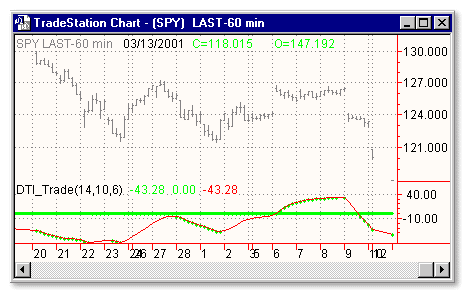Download: Tsi_etc.ela
File Includes:
Indicator - DTI_Trade
Function - DTI
Function - DTI_Trade
Function - HMU
Function - LMD
Function - MDI
Function - TSI
Function - TVI
Function - DXAverage
Function - TXAverage
Indicator - *DTI Signal
Indicator - DTI
Indicator - Ergotic_CSI
Indicator - Ergotic_MACD
Indicator - Ergotic_MDI
Indicator - Ergotic_TSI
Indicator - Ergotic_TSI-2
Indicator - Ergotic_TVI
Category: Indicator > Miscellaneous
Description:
This is one of the techniques described by William Blau in his book "Momentum, Direction and Divergence" (1995). If you like to learn
more, we advise you to read this book. His book focuses on three key aspects of trading: momentum, direction and divergence. Blau, who was an electrical engineer before becoming a trader, thoroughly examines the relationship between price and momentum in step-by-step examples. From this grounding, he then looks at the deficiencies in other oscillators and introduces some innovative techniques, including a fresh twist on Stochastics. On directional issues, he analyzes the intricacies of ADX and offers a unique approach to help define trending and non-trending periods.
Usage:
Directional Trend Index is an indicator similar to DM+ developed by Welles Wilder. The DM+ (a part of Directional Movement System which includes both DM+ and DM- indicators) indicator helps determine if a security is "trending." William Blau added to it overbought/oversold lines with user-defined parameters. As a result the advantage is double: both the strength of the trend and overbought/oversold conditions of the market can be monitiored at once.

Inputs:
r - specifies the number of bars to consider
s - specifies the number of bars to consider
u - specifies the number of bars to consider
EasyLanguage Code:
{}
INPUTS: R(14), S(10), U(6);
PLOT1(DTI_TRADE(R, S, U), "DTI_TRADE");
PLOT2(0, "ZLINE");
PLOT3(DTI(R, S, U), "DTI");